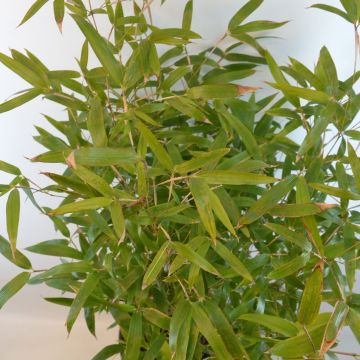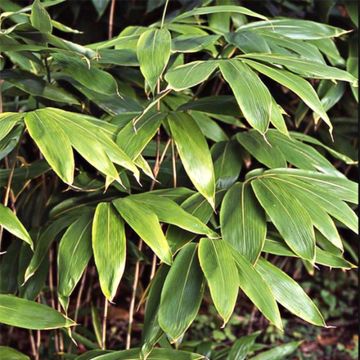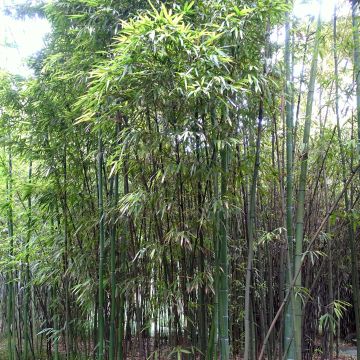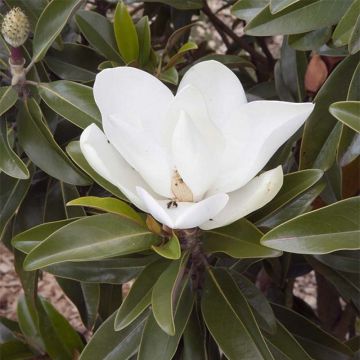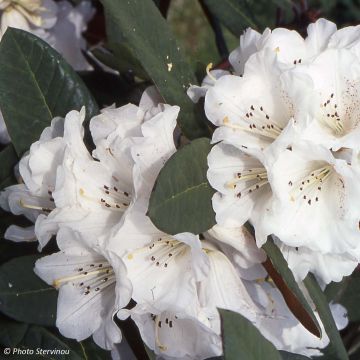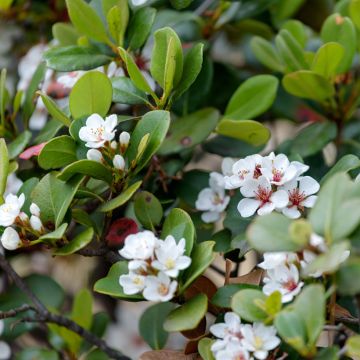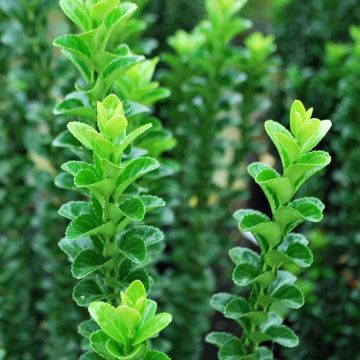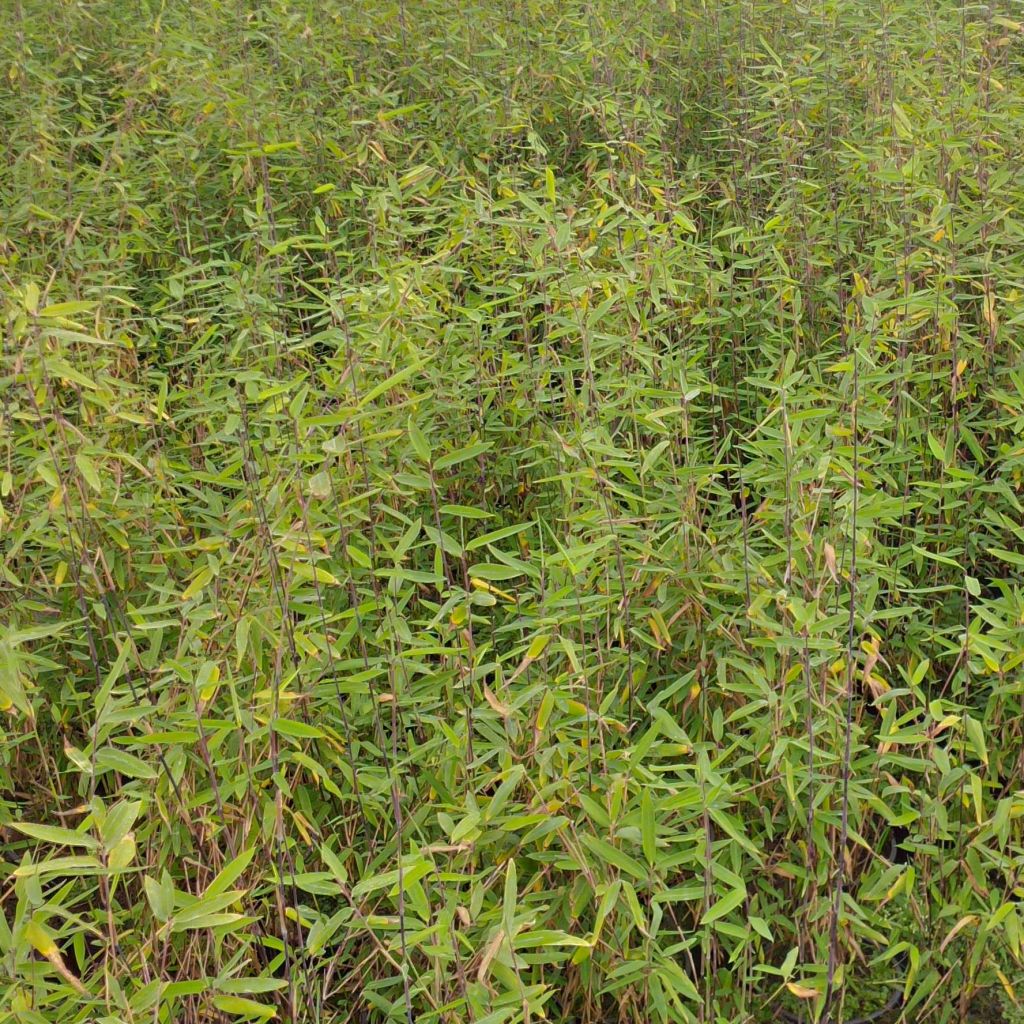

Fargesia demissa Gerry - Bambou non traçant
Fargesia demissa Gerry
Fargesia demissa Gerry
Fountain Bamboo, Umbrella Bamboo
This item cannot be shipped to the selected country
Delivery charge from €5.90
More information
Schedule delivery date,
and select date in basket
This plant carries a 24 months recovery warranty
More information
We guarantee the quality of our plants for a full growing cycle, and will replace at our expense any plant that fails to recover under normal climatic and planting conditions.
From €5.90 for pickup delivery and €6.90 for home delivery
Express home delivery from €8.90.
Does this plant fit my garden?
Set up your Plantfit profile →
Description
The Fargesia demissa 'Gerry' is a relatively new type of non-invasive bamboo plant that is exceptionally hardy and highly ornamental. Its culms are reasonably thick and display beautiful colours that range from dark purple with a bluish-purple bloom to green over time. This provides a stunning contrast with the dark green foliage. It has a very upright, almost columnar habit, making it perfect as a standalone plant in a container on a terrace or balcony. Its foliage is primarily evergreen or deciduous to withstand harsh frosts in cooler climates. Like all Fargesia plants, it grows quickly in height but spreads slowly over the years without ever becoming invasive. Plant it in partial shade, fresh and fertile soil for best results, preferably non-chalky.
The Fargesia demissa, closely related to Fargesia nitida, is a plant of the Poaceae family, a type of grass with woody stems that develops from a non-invasive rhizomatous base, referred to as clump-forming. In this type of bamboo, the rhizomes with very short internodes develop slowly at the periphery of the stump without becoming bare in the centre. Fargesia demissa is native to the north of China, and is one of the hardiest bamboos, capable of withstanding -30°C (-22 °F) in winter without suffering. The cultivar 'Gerry', recently arrived from the Netherlands, was recognised as "Bamboo of the Year" in Germany in 2014. It forms a rather erect and narrow clump, slightly flaring upwards, reaching an average height of 2m (6 ft 7 in) in a container, up to 3.50m (11 ft 6 in) in the ground if conditions are optimal. Its growth is fast, around 30 to 40cm (11.8 to 15.7 in) per year, depending on the growing conditions. Eventually, the plant will spread about 1m (3 ft 4 in) to 1.50m (4 ft 11 in) on the ground. The culms are upright stems, quite thick for a Fargesia, measuring 2 to 3cm (0.8 to 1.2 in) in diameter. When they emerge from the ground, they are purplish and covered with a pastel blue-mauve bloom that remain for quite some time during the culm's growth, so that the wood appears marbled with violet, plum, and bluish mauve on the year's growth. An exceptional colouration that gives way to green on mature culms. The foliage is more or less evergreen, completely deciduous below -20°C (-4 °F). Abundant, the leaves are of medium size, lanceolate and tapering at the end, with a fairly dark green colour and a matte finish.
The remarkably colourful, slender and fast-growing Fargesia 'Gerry' is perfect as a standalone shrub or in a large pot or container on the balcony or terrace. It can also be used, alone or in combination with other Fargesia, to create a windbreak or a noise screen. It blends well with a shrub border, such as Japanese maples, hydrangeas, and Mahonia. For example, you can plant a Brunnera macrophylla 'Jack Frost' at its base and surround it with lush perennials: large grasses, giant cannas, and tall dahlias (Dahlia imperialis) will also be good companions for this magnificent bamboo. To add colour to its foliage in a surprising way in summer, you can plant it with a viticella-type clematis with red flowers (Madame Julia Correvon, purpurea Plena Elegans, Avant Garde) whose stems will twine around the black culms, their small foliage blending very naturally into the 'Gerry' bamboo.
Report an error about the product description
Fargesia demissa Gerry in pictures


Plant habit
Foliage
Botanical data
Fargesia
demissa
Gerry
Poaceae
Fountain Bamboo, Umbrella Bamboo
Cultivar or hybrid
Other Bamboos
Planting and care
The Fargesia demissa 'Gerry' does well in partially or fully shaded areas, especially in warm climates. It's sensitive to too much sun and drought, so keeping it in a shady position and well-watered is essential. When planting, choose moist, rich soil, and avoid limestone. It's best to plant in the spring or autumn in mild climates and leave enough space to grow over time, as it can spread up to 10 metres (32 feet 10 inches). The mature plant requires about 20 litres of water per week during hot periods and 10 litres for the rest of the year. If you choose to plant it in a pot, monitor watering carefully and add two handfuls of fertiliser at the base of the bamboo from early March to mid-April. This will help keep its foliage green. Be aware that slugs can eat young shoots. Unlike other Fargesia types, this non-invasive bamboo doesn't require a rhizome barrier when planting. It retains its green foliage in winter but may lose some leaves depending on the temperature throughout the year..
Planting period
Intended location
Care
-
, onOrder confirmed
Reply from on Promesse de fleurs
Evergreen shrubs
Haven't found what you were looking for?
Hardiness is the lowest winter temperature a plant can endure without suffering serious damage or even dying. However, hardiness is affected by location (a sheltered area, such as a patio), protection (winter cover) and soil type (hardiness is improved by well-drained soil).

Photo Sharing Terms & Conditions
In order to encourage gardeners to interact and share their experiences, Promesse de fleurs offers various media enabling content to be uploaded onto its Site - in particular via the ‘Photo sharing’ module.
The User agrees to refrain from:
- Posting any content that is illegal, prejudicial, insulting, racist, inciteful to hatred, revisionist, contrary to public decency, that infringes on privacy or on the privacy rights of third parties, in particular the publicity rights of persons and goods, intellectual property rights, or the right to privacy.
- Submitting content on behalf of a third party;
- Impersonate the identity of a third party and/or publish any personal information about a third party;
In general, the User undertakes to refrain from any unethical behaviour.
All Content (in particular text, comments, files, images, photos, videos, creative works, etc.), which may be subject to property or intellectual property rights, image or other private rights, shall remain the property of the User, subject to the limited rights granted by the terms of the licence granted by Promesse de fleurs as stated below. Users are at liberty to publish or not to publish such Content on the Site, notably via the ‘Photo Sharing’ facility, and accept that this Content shall be made public and freely accessible, notably on the Internet.
Users further acknowledge, undertake to have ,and guarantee that they hold all necessary rights and permissions to publish such material on the Site, in particular with regard to the legislation in force pertaining to any privacy, property, intellectual property, image, or contractual rights, or rights of any other nature. By publishing such Content on the Site, Users acknowledge accepting full liability as publishers of the Content within the meaning of the law, and grant Promesse de fleurs, free of charge, an inclusive, worldwide licence for the said Content for the entire duration of its publication, including all reproduction, representation, up/downloading, displaying, performing, transmission, and storage rights.
Users also grant permission for their name to be linked to the Content and accept that this link may not always be made available.
By engaging in posting material, Users consent to their Content becoming automatically accessible on the Internet, in particular on other sites and/or blogs and/or web pages of the Promesse de fleurs site, including in particular social pages and the Promesse de fleurs catalogue.
Users may secure the removal of entrusted content free of charge by issuing a simple request via our contact form.
The flowering period indicated on our website applies to countries and regions located in USDA zone 8 (France, the United Kingdom, Ireland, the Netherlands, etc.)
It will vary according to where you live:
- In zones 9 to 10 (Italy, Spain, Greece, etc.), flowering will occur about 2 to 4 weeks earlier.
- In zones 6 to 7 (Germany, Poland, Slovenia, and lower mountainous regions), flowering will be delayed by 2 to 3 weeks.
- In zone 5 (Central Europe, Scandinavia), blooming will be delayed by 3 to 5 weeks.
In temperate climates, pruning of spring-flowering shrubs (forsythia, spireas, etc.) should be done just after flowering.
Pruning of summer-flowering shrubs (Indian Lilac, Perovskia, etc.) can be done in winter or spring.
In cold regions as well as with frost-sensitive plants, avoid pruning too early when severe frosts may still occur.
The planting period indicated on our website applies to countries and regions located in USDA zone 8 (France, United Kingdom, Ireland, Netherlands).
It will vary according to where you live:
- In Mediterranean zones (Marseille, Madrid, Milan, etc.), autumn and winter are the best planting periods.
- In continental zones (Strasbourg, Munich, Vienna, etc.), delay planting by 2 to 3 weeks in spring and bring it forward by 2 to 4 weeks in autumn.
- In mountainous regions (the Alps, Pyrenees, Carpathians, etc.), it is best to plant in late spring (May-June) or late summer (August-September).
The harvesting period indicated on our website applies to countries and regions in USDA zone 8 (France, England, Ireland, the Netherlands).
In colder areas (Scandinavia, Poland, Austria...) fruit and vegetable harvests are likely to be delayed by 3-4 weeks.
In warmer areas (Italy, Spain, Greece, etc.), harvesting will probably take place earlier, depending on weather conditions.
The sowing periods indicated on our website apply to countries and regions within USDA Zone 8 (France, UK, Ireland, Netherlands).
In colder areas (Scandinavia, Poland, Austria...), delay any outdoor sowing by 3-4 weeks, or sow under glass.
In warmer climes (Italy, Spain, Greece, etc.), bring outdoor sowing forward by a few weeks.

































